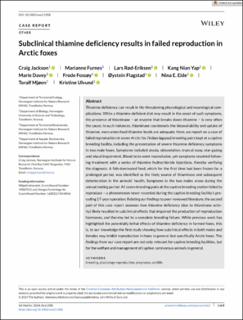| dc.contributor.author | Jackson, Craig Ryan | |
| dc.contributor.author | Furnes, Marianne Waldum | |
| dc.contributor.author | Rød-Eriksen, Lars | |
| dc.contributor.author | Yap, Kang Nian | |
| dc.contributor.author | Davey, Marie Louise | |
| dc.contributor.author | Fossøy, Frode | |
| dc.contributor.author | Flagstad, Øystein | |
| dc.contributor.author | Eide, Nina Elisabeth | |
| dc.contributor.author | Ulvund, Kristine R. | |
| dc.date.accessioned | 2024-03-19T08:39:23Z | |
| dc.date.available | 2024-03-19T08:39:23Z | |
| dc.date.created | 2024-02-16T09:38:58Z | |
| dc.date.issued | 2024 | |
| dc.identifier.issn | 2053-1095 | |
| dc.identifier.uri | https://hdl.handle.net/11250/3123004 | |
| dc.description.abstract | Thiamine deficiency can result in life-threatening physiological and neurological complications. While a thiamine-deficient diet may result in the onset of such symptoms, the presence of thiaminase – an enzyme that breaks down thiamine – is very often the cause. In such instances, thiaminase counteracts the bioavailability and uptake of thiamine, even when food-thiamine levels are adequate. Here, we report on a case of failed reproduction in seven Arctic fox (Vulpes lagopus) breeding pairs kept at a captive breeding facility, including the presentation of severe thiamine deficiency symptoms in two male foxes. Symptoms included ataxia, obtundation, truncal sway, star-gazing and visual impairment. Blood tests were inconclusive, yet symptoms resolved following treatment with a series of thiamine hydrochloride injections, thereby verifying the diagnosis. A fish-dominated feed, which for the first time had been frozen for a prolonged period, was identified as the likely source of thiaminase and subsequent deterioration in the animals’ health. Symptoms in the two males arose during the annual mating period. All seven breeding pairs at the captive breeding station failed to reproduce – a phenomenon never recorded during the captive breeding facility's preceding 17-year operation. Relating our findings to peer-reviewed literature, the second part of this case report assesses how thiamine deficiency (due to thiaminase activity) likely resulted in subclinical effects that impaired the production of reproduction hormones, and thereby led to a complete breeding failure. While previous work has highlighted the potentially lethal effects of thiamine deficiency in farmed foxes, this is, to our knowledge the first study showing how subclinical effects in both males and females may inhibit reproduction in foxes in general, but specifically Arctic foxes. The findings from our case report are not only relevant for captive breeding facilities, but for the welfare and management of captive carnivorous animals in general. breeding,physiology-reproductive,pregnancy,wildlife | en_US |
| dc.language.iso | eng | en_US |
| dc.publisher | Wiley | en_US |
| dc.rights | Attribution-NonCommercial-NoDerivatives 4.0 Internasjonal | * |
| dc.rights.uri | http://creativecommons.org/licenses/by-nc-nd/4.0/deed.no | * |
| dc.title | Subclinical thiamine deficiency results in failed reproduction in Arctic foxes | en_US |
| dc.title.alternative | Subclinical thiamine deficiency results in failed reproduction in Arctic foxes | en_US |
| dc.type | Peer reviewed | en_US |
| dc.type | Journal article | en_US |
| dc.description.version | publishedVersion | en_US |
| dc.subject.nsi | VDP::Zoologiske og botaniske fag: 480 | en_US |
| dc.subject.nsi | VDP::Zoology and botany: 480 | en_US |
| dc.subject.nsi | VDP::Zoologiske og botaniske fag: 480 | en_US |
| dc.subject.nsi | VDP::Zoology and botany: 480 | en_US |
| dc.source.volume | 10 | en_US |
| dc.source.journal | Veterinary Medicine and Science | en_US |
| dc.source.issue | 2 | en_US |
| dc.identifier.doi | 10.1002/vms3.1358 | |
| dc.identifier.cristin | 2246653 | |
| dc.relation.project | Norges forskningsråd: 160022/F40 | en_US |
| dc.relation.project | Miljødirektoratet: 19087015 | en_US |
| cristin.ispublished | true | |
| cristin.fulltext | original | |
| cristin.qualitycode | 1 | |

